Categories
About UsHow to get startedAccount AccessBrokers and TradingChartsScannersCommunityStocksOptionsFuturesAlertsMobile AppSaving, Importing, and Exporting Layouts
As you use the platform in your day-to-day market analysis routine, you will inevitably build up a certain set of tools, charts, and scanners that are part of your process. Having to recreate these configurations every time they are needed is of course a waste of time, which is exactly why WealthCharts offers its main go-to method of saving progress – Layouts.
A layout is a global way of saving everything that is in it, which includes any dashboards that you have open currently as well as the content of every single dashboard to the smallest detail – chart settings, indicators and settings, scanners, filters, window sizes, symbol, and timeframe links settings, etc. Please note that a dashboard and a layout are different terms, and a single layout can contain multiple dashboards inside it. A layout also typically occupies a browser tab of its own, and multiple layouts can be used simultaneously by making use of multiple browser tabs, or even entire browser windows.
Layouts can be accessed and managed from a couple of areas in the platform, which we will look at further down the road, but the most important menu that has all the details regarding a layout is the “Layouts Menu” dropdown at the very top of your hamburger/main menu in the top left corner:
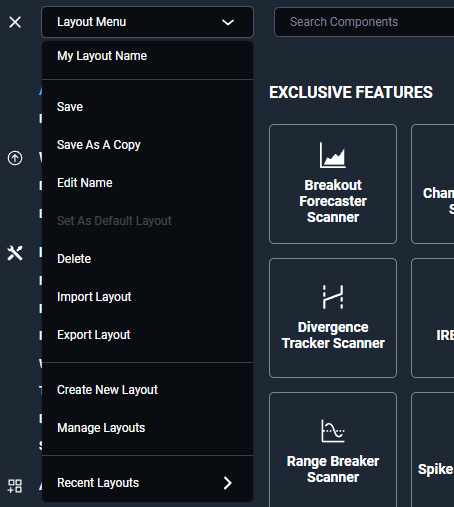
The layout Menu dropdown contains a number of important features, listed in the same order as below:
The name of the layout that is currently open – You can always check which layout you’re in currently by looking here. Note that the layout name will also be displayed in the browser tab!
Save – This button is only available when you are in an existing layout and allows you to save the layout that is currently open. If you have made any changes to your layout recently, clicking on this will ensure that these changes are retained.
Save As A Copy – This is an equivalent of the traditional “Save As” button that you may be familiar with from other applications such as text or spreadsheet editors. Clicking on this will prompt you to give your layout a name, an optional description, and save it as a brand new, separate, and unique layout. You will also find a “Save As Copy and Make Default” button here, which unites two actions in one – saves the layout you’re creating and also immediately designates it as the default one that will load up automatically when you start up your platform.
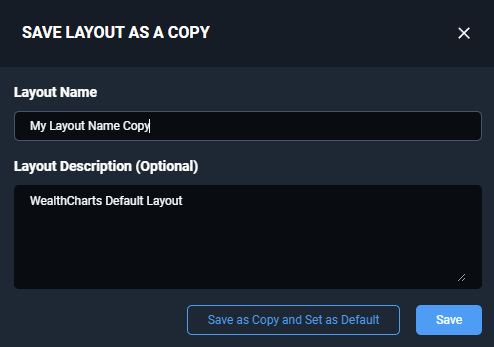
Edit Name – This button is only available when you are in an existing layout. Clicking this calls up a window similar to the one available when saving your layout, and here you can change the Name or the description of the layout you’re in right now.
Set As Default Layout – This button allows you to designate the layout that is open currently as the default one. Doing this will ensure that this is the layout that loads up automatically whenever you open your trading platform going forward. If the layout you’re in is already the default one, this button will be greyed out.
Delete – Using this button, you can delete the layout that is currently open. Beware – this action cannot be undone!
Export Layout – Any layout can be exported and shared with a fellow WealthCharts user. Our support team may also ask you to do this occasionally if you run into any difficulties with setting up your layout. Exporting a Layout to someone else allows them to import a copy of that layout and make changes to it on their end as needed. When you click this button, a window will show up with an export code – this code can be shared with the user that you would like to export the layout to.

Import Layout – If someone has shared a layout export code with you, you may use this button to import the layout. Clicking it will take you to a window where the layout code can be pasted, and after importing it you will be able to use this layout as your own.

Create New Layout – This button allows you to start with a new, completely empty layout from scratch if you need a clean start. Using the button will call up a window where you can give your layout a name and a description, and once done, the new but empty layout will load up on your screen. From here, proceed to populate it with charts, features and dashboards that you would like to see in it, and don’t forget to save!
Manage Layouts – This is one of the most important menus here, and the spot where you can manage and access the layouts that you have available to you:
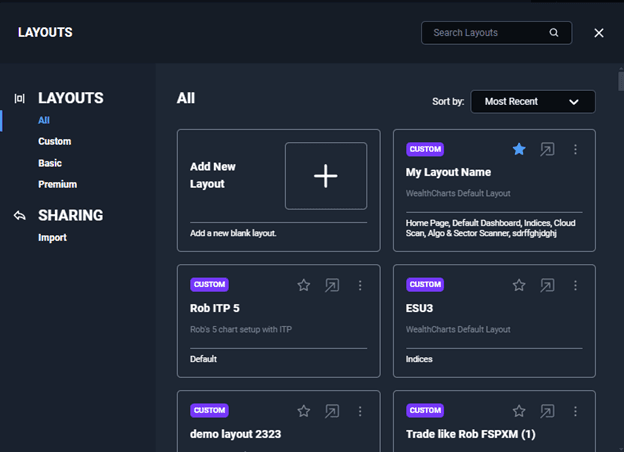
Each layout is listed here as a separate tile, offering some information about the layout itself – the layout name, the description (if available), and a summary of the dashboards contained within that layout. Three important buttons are also available in the top right corner of each layout tile:
Set as default – this button looks like a star and can be clicked to make a layout the default one. Doing this will ensure that this is the layout that loads up automatically whenever you open your trading platform going forward.
Open in new tab – clicking this button opens the layout in question, but in a new browser tab.
Manage layout – this button looks like three dots, and calls up a menu where some action can be made with your layout: Here, you can edit the name of the layout, create a duplicate copy of the layout, export it with a layout export code, and delete the layout completely.

Layout Categories
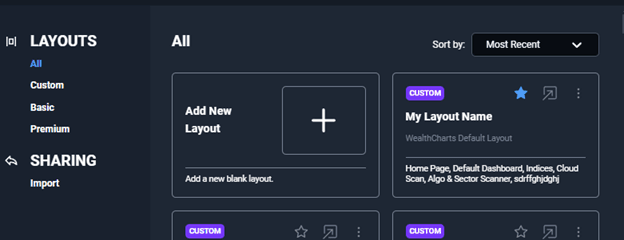
Layouts are split up into multiple categories, which can be used to navigate through the Manage Layouts menu. These include the following categories:
All – All of your layouts will be displayed here regardless of category.
Custom – Any custom layouts that you have created or saved yourself fall under this category. Imported layouts are also considered custom layouts. Custom layouts will have a purple “custom” label showing up on them.
Basic – These are basic layouts, designed to demonstrate some of the functionality available in the platform and provide you with some basic item grids. Basic layouts will have a grey “basic” label showing up on them.
Premium – These are some of the more advanced pre-configured layouts, custom-built for specific use cases, or provider by some of the trading experts and educators on the WealthCharts team. Premium layouts will have a green “premium” label showing up on them.
Recent Layouts

Using this menu in the dropdown, you can view and access any of the layouts that you have used recently. The layouts here are listed in chronological order based on when you have accessed them last, and an “Open in New Browser Tab” button (looks like an arrow pointing at a square) is available next to each entry.
Accessing Layouts via Main Menu
As mentioned earlier, layouts can be accessed in multiple spots on the platform. Another such area is the “Layouts” category in the Main Menu of the platform:
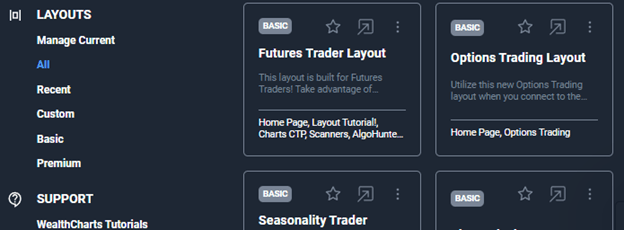
Here you can do most of what you are also able to do in the Manage Layouts menu: view and access layouts by category, see the current layout, select the default layout and make edits.
Layout Quick Save Button
A “Save Layout” shortcut is available in the top right corner of your trading platform. Clicking this in a layout that has not been saved yet will trigger the “Save As a Copy action, while clicking this in an existing layout will save any changes made within the layout that is currently open.
